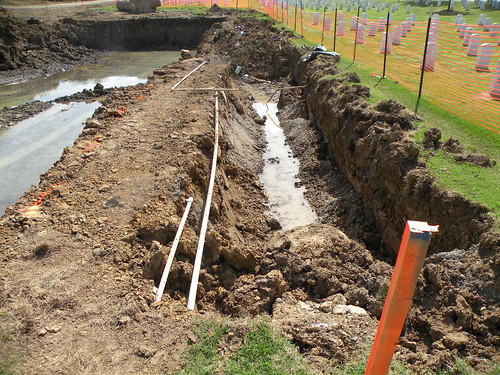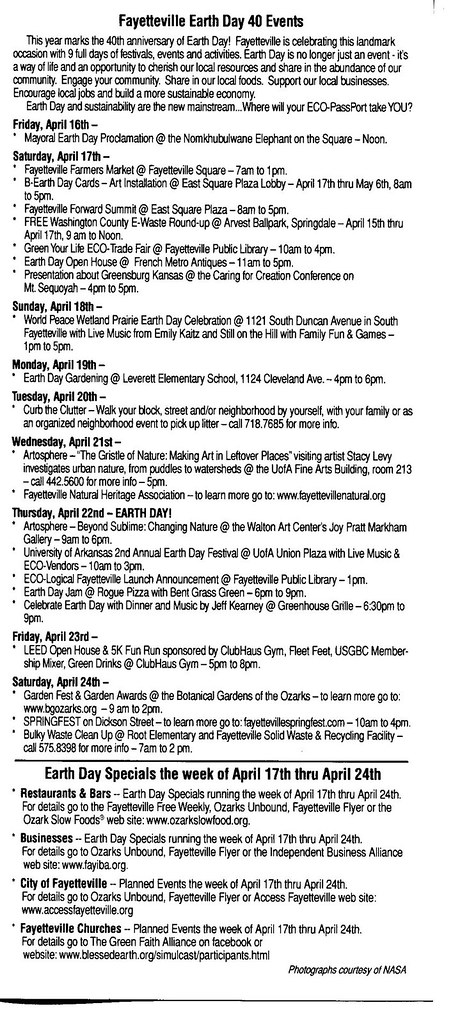Please click on individual images to ENLARGE view of immature and adult male cardinals feeding on Ambrosia trifida in September 2010.
September and October are feasting months for locally fledged birds as well as the hoards of migrating birds that find Ambrosia trifida a special native treat in Fayetteville, Arkansas. The importance of allowing native plants to go to seed and remain standing as "feeders with legs" cannot be overemphasized.
Monday, December 27, 2010
Saturday, December 18, 2010
Jim Bemis speaks at Telecom Board meeting on December 16, 2010
GOVERNMENT CHANNEL SCHEDULE published Friday, December 17, 2010, the day following Telecom Board meeting, does not include Telecom Board meeting video to be run during week of 12/17/2010 through 12/12/2010. Bemis' comments, therefore, will not be shown on Cox Cable or AT&T U-verse until long after the Fayetteville City Council meeting at which the CAT contract will be voted on Tuesday, December 21, 2010.
Please click on individual pages to ENLARGE for easy reading.
Sunday, November 21, 2010
Wednesday, November 10, 2010
aubunique: Fayetteville, Arkansas, and Charleston, South Caro...
aubunique: Fayetteville, Arkansas, and Charleston, South Caro...: "The Home Depot Foundation Tackles Cities’ Sustainability Challenges with Innovative Program Two Cities Selected for $1 Million Invest..."
Tuesday, November 9, 2010
aubunique: Please fill out online survey of opinion of perfor...
aubunique: Please fill out online survey of opinion of perfor...: "Greetings Everyone! CAT Performance Survey 2010 As we reach the end of 2010, Community Access Television (CAT) requests the favor of yo..."
Wednesday, October 20, 2010
Sunday, October 17, 2010
Highway Commission vote could end mowing and dredging practices that cause erosion, loss of wildlife habitat and decrease beauty of roadsides in Arkansas
Please click on image to ENLARGE. Two hours after this photo was made on October 12, 2010, this area had been brushogged into oblivion. Sure, the swamp milkweed will sprout from its roots next summer. But these plants not only held pods offering hundreds of milkweed seeds but also were feeding milkweed caterpillars that could have made chrysalises and become final 2010 generation monarchs traveling to Mexico and with a chance to return in spring and find fresh milkweed on which a new generation of monarchs could have been raised to keep the cycle of life intact for this seriously threatened species of migrating butterfly. If you want to talk to your Northwest Arkansas representative on the Highway Commission, he is Dick Trammel.
Monarch caterpillars were still eating the foliage of these swamp milkweeds and the seed pods were almost mature when the Arkansas Highway and Transportation Department Mowers came down the road and crushed and cut them off near the ground. Amazing hypocrisy for a state agency that touts its wildflower program. And possibly worse hypocrisy is touting its stormwater-protection work and then mowing and dredging ditches repeatedly every year.
Please click on individual images to ENLARGE view.
To learn more about the Arkansas Highway Commission, please see AHC link.
Monarch caterpillars were still eating the foliage of these swamp milkweeds and the seed pods were almost mature when the Arkansas Highway and Transportation Department Mowers came down the road and crushed and cut them off near the ground. Amazing hypocrisy for a state agency that touts its wildflower program. And possibly worse hypocrisy is touting its stormwater-protection work and then mowing and dredging ditches repeatedly every year.
Please click on individual images to ENLARGE view.
To learn more about the Arkansas Highway Commission, please see AHC link.
Thursday, October 14, 2010
aubunique: Fayetteville's David Whitaker's debate with mayor ...
aubunique: Fayetteville's David Whitaker's debate with mayor ...: "John Gray debated Blanche Lincoln, John Boozman and Trevor Drown for a Senate seat from Arkansas yesterday. Link to video on AETN Web site. ..."
Wednesday, October 6, 2010
aubunique: Insect Festival coming up
aubunique: Insect Festival coming up: "Please use live links on site to navigate and read more detail. Bumpers College Home Entomology Home O..."
aubunique: Tree and Landscape Committee sets annual city tree...
aubunique: Tree and Landscape Committee sets annual city tree...: "12th Annual Celebration of TreesSaturday October 9, 2010 7:00 am Town Center entrance on the Fayetteville SquareEvery year the Tree and Lan..."
Wednesday, September 22, 2010
Friday, August 27, 2010
Sunday, August 15, 2010
Two such wetland plants growing together are a strong indicator of wetland
Please click on image to ENLARGE and widen view of Asclepias incarnata (swamp milkweed) and Verbena hastata (swamp vervain) growing together on south Fayetteville wetland.
Friday, July 23, 2010
Thursday, July 22, 2010
Sunday, July 18, 2010
Tuesday, July 13, 2010
NCAT announces that Arkansas among 3 states chosen to launch National Energy Corps program
Arkansas Chosen as One of 3 States to Launch National Energy Corps Program
The National Center for Appropriate Technology (NCAT) is pleased to announce that it has been awarded funding from the Corporation for National and Community Service to launch the National Energy Corps AmeriCorps program.
By forming collaborations with local non-profit organizations, community action agencies, local governments and energy service organizations, the National Energy Corps initiative will foster community sustainability by addressing the core challenges of clean energy:
* Hands-on Energy Assistance
* Energy Education and Outreach
* Community Energy Planning and Organizing
* Green Jobs Training and Skills Development
* Energy Education and Outreach
* Community Energy Planning and Organizing
* Green Jobs Training and Skills Development
The National Energy Corps program is an AmeriCorps initiative of the National Center for Appropriate Technology (NCAT) in cooperation with The Corporation for National and Community Service that was created to address unmet community energy needs by promoting sustainable energy consumption and
education, fostering community sustainability and helping to mitigate the effects of global climate change.
The National Energy Corps initiative builds on the success of the Montana Energy Corps pilot, a program funded by the Montana Governor’s Office of Community Service. Since October of 2009, Energy Corps members in Montana have been busy assisting with weatherization services for low-incomes areas,
developing clean energy awareness campaigns for communities and performing community building energy audits on reservations.
“We see a need for sustainable energy services across the country,” says Energy Corps Program Director Holly Hill. “The Energy Corps program has been a great success in Montana and we hope we can replicate that success on a larger scale.”
As a product of the successful Montana Energy Corps program, the National Energy Corps initiative will launch this fall in three additional states, Pennsylvania, Iowa and Arkansas. The Arkansas Energy Corps program will be managed by the NCAT Southeast Regional Office, located in Fayetteville, Arkansas.
NCAT Southeast Regional Office Director Margo Hale says, “The Southeast Regional office is thrilled to be one of three states to launch the National Energy Corps initiative. This is a great opportunity for our region and our state.”
Arkansas will have approximately 15 National Energy Corps positions available, beginning in September 2010. Energy Corps members will serve an 11 month term of service and receive the same benefits as an AmeriCorps member, which include a monthly living stipend, an education award, health insurance
and a experience of a lifetime providing direct services to their community. National Energy Corps members will be placed with host organizations in communities throughout the state of Arkansas to implement solutions for sustainable energy.
NCAT is currently accepting applications from non-profit organizations interested in hosting an Energy Corps member. Host organizations will be required to provide a detailed description of how an Energy Corps member working for their program will facilitate clean energy-related services.
Applications for host organizations must be submitted by the close of business by July 20, 2010. More detailed information regarding this partnership opportunity is available by reviewing the full application instructions attached or by contacting Holly Hill at 406-494-8652/hollyh@ncat.org or Melissa Terry at 479.575.1382/melissat@ncat.org.
###
The National Center for Appropriate Technology is a nonprofit organization founded in 1976. NCAT’s innovative and diverse projects in the fields of
sustainable energy, sustainable agriculture and rural community development are supported by foundations, government/private sector grants and contracts, as well as through individual contributions and memberships.
--
AR Energy Corps Coordinator
National Center for Appropriate Technology
SE Field Office
207 W. Center
Fayetteville, AR 72701
www.ncat.org
479.575.1385
Sunday, July 4, 2010
Friday, June 11, 2010
This buckeye butterfly was on nonnative butterfly bush in the peace-circle portion of the World Peace Wetland Prairie on June 11, 2010. You may be able to see it and many other pollinators Saturday June 12, 2010, at some of the 8 private gardens on the OMNI Tour of Peace Gardens
Please click on image to ENLARGE view of Buddleia with
Precis coenea nectaring on it on June 11, 2010, at World Peace Wetland Prairie in Fayetteville, Arkansas.
For interactive map and information about 2010 OMNI Peace Garden Tour, please see OMNI Peace Gardens blog.
Precis coenea nectaring on it on June 11, 2010, at World Peace Wetland Prairie in Fayetteville, Arkansas.
For interactive map and information about 2010 OMNI Peace Garden Tour, please see OMNI Peace Gardens blog.
Tuesday, June 8, 2010
Bill Halter choice of Democratic voters in Washington County
Thursday, June 3, 2010
Sunday, May 30, 2010
Denver tolerates no fireworks, so why should Fayetteville weaken its rules?
The only argument that might make me hesitate to think for even a moment before condemning the current discussion by Fayetteville city government about softening the firework ordinance would be that shooting off fireworks on fourth of July is patriotic.
Visit with a Vietnam or middle-east vet living in the hillside woodlands and stream riparizn zones in south Fayetteville and ask about their reactions to the sounds of fireworks. Some may be afraid to talk to you. Others will explain exactly what their generation experienced that led to the replacement of the WWI classification of shell-shocked with "victims of post-dramatic trauma."
If you don't care about the human victims of the intrusive noise of fireworks, how about the thousands of pets that disappear in the vain attempt to escape the pain of firework noise.
Whatever one calls it, a person who has been helpless under heavy fire in battle usually doesn't enjoy fireworks. Especially if he lives as quietly as possible in a Fayetteville forested area and is awakened in his bed on the ground by assorted expensive fireworks lighting the sky above him.
Denver's zero tolerance firework policy outlined
POSTED: 06/30/2009 12:53:58 PM MDT
UPDATED: 06/30/2009 07:20:35 PM MDT
Denver has zero tolerance for fireworks.
That means fireworks can't be stored, used, manufactured or sold in Denver.
Today, Denver police and paramedics gathered outside the emergency room at Denver Health Medical Center and used graphic pictures to illustrate why the city has the policy.
Mangled fingers. Mutilated arms. Badly burned hands and faces.
"The only things that are legal are non-ignitable items such as paper-wrapped, small poppers," said Denver Police Technician Dean Christopherson. "We allow nothing that ignites or explodes."
The prohibition includes sparklers.
"The problem with sparklers are that they burn at over a thousand degrees," he said. "They are very flammable. Anything that you have around
them could set a lot of fires."
Christopherson said another consideration is the hope that the "quality of life" can be preserved in Denver.
He said the vast majority of fireworks calls are in the evening as people try to sleep and pets are "trying to get some peace."
Setting off the fireworks wakes some and upsets the pets, he said.
Lt. Scott Homlar, a lieutenant with Denver Paramedic Division, said that annually in the United States between 8,000 and 10,000 emergency room visits are caused by fireworks injuries.
The vast majority of the blast and burn victims are kids 15 years and younger and most injuries occur in the months around July 4th, Homlar said.
"You have to understand that these are little explosives," said Homlar. "Most of the injuries are either to the head or to the extremities — to the hands, eyes, ears and facial injuries."
Christopherson said that so far this year, there have been about 350 complaints about fireworks in Denver, which is half the number of the calls at this time last year.
He said it could be the result of a down economy, a lack of available fireworks or people obeying the law.
He noted that the maximum penalty for setting off fireworks in Denver is a
fine up to $999 and one year in jail.
Homlar said he has personally treated people injured by fireworks. "Fortunately, it is not a common occurrence," he said. "I think it is reflective of the law in Denver which makes it illegal for people to even possess the items."
Still, Homlar doesn't want to be a holiday killjoy. "We want you to have a good time, we want you to have an enjoyable 4th of July but we want you to be legal," he said.
To report the use of illegal fireworks in Denver, call police either at 311 or 720-913-2000.
Howard Pankratz: 303-954-1939 or hpankratz@denverpost.com
Tuesday, May 18, 2010
Halter fans plentiful in downtown Fayetteville on night before senatorial primary election
Saturday, April 24, 2010
Green infrastructure still being destroyed: Boozeman, Lincoln and Pryor all promised in 2009 to cooperate to get federal money appropriated to buy sale-barn property; instead, their failure to act has resulted in wet-prairie land north and west of the National Cemetery being dredged and filled for burial sites
Fayetteville National Cemetery photo set. Scroll to bottom of set for more of today's photos This didn't have to happen. Could it be related to the fact that none of the three is a U.S. military veteran? Or did they have more important people's votes in mind? The percentage of veterans who vote is pretty high. The right to vote has always been a reason for many to agree to fight to protect our Democratic form of government.  Please click on image to ENLARGE view of land dredging at Fayetteville National Cemetery on April 23, 2010.
Please click on image to ENLARGE view of land dredging at Fayetteville National Cemetery on April 23, 2010.
 Please click on image to ENLARGE view of land dredging at Fayetteville National Cemetery on April 23, 2010.
Please click on image to ENLARGE view of land dredging at Fayetteville National Cemetery on April 23, 2010.
Friday, April 16, 2010
Earth Day Festival began Friday night with Caring for Creation at Mount Sequoyah; Earth Day at World Peace Wetland Prairie from 1 to 5 p.m. Sunday, April 18, 2010, offers eduction and fun for all ages
Please click on image to ENLARGE for closer view of sample photos from WPWP.
PLEASE double-click the image to ENLARGE view and ENLARGE further with your computer's tools to read small type. For more about World Peace Wetland Prairie please see www.flickr.com/photos/7295307@N02/collections/ www.flickr.com/photos/7295307@N02/collections/
PLEASE double-click the image to ENLARGE view and ENLARGE further with your computer's tools to read small type.
MANY REASONS TO PROTECT LAND SUCH AS WORLD PEACE WETLAND AND PINNACLE PRAIRIE FOREVER:
World Peace Wetland Prairie is the riparian zone of a small stream that historically was fed by seep springs and rainwater from three directions when the first westward immigrants settled Fayetteville, Arkansas. World Peace Wetland Prairie has the deepest layer of dark, rich soil in its subwatershed because leaves and other vegetative matter accumulated as the flowing water slowed and soaked into the absorbent soil and enriched that soil. Pinnacle Foods Inc.'s mounded wet prairie to the west is the main source of clean water flowing to World Peace Wetland Prairie at this time. Before the railroad was built, water flowed off Rochier Hill to the northwest and from the prairie and savannah to the north of WPWP that has been replaced by fill dirt and paving for apartments. Water from the east and north slopes of the high land where Pinnacle Foods Inc. now sits flowed to WPWP along with all the water from the high ground near 15th Street, which moved north to WPWP before flowing east to the Town Branch of the West Fork of the White River. Such remnants of prairie help keep the water where it falls and recharge the groundwater. Like the many similar remnants of such prairie in our diverse geographical area, WPWP and Pinnacle Prairie are the surface manifestation of a significant bedrock fault. Such sunken wetland is a characteristic feature that appears above geological faults worldwide. The Karst map of Washington County Arkansas shows the WPWP watershed in red, meaning that it is a critical groundwater recharge area. Preserving such depressional wetland in our city is the least expensive way to reduce downstream flooding and siltation of our water supply. Hundreds of native plants grow. Many birds and other wildlife prosper on healthy wetland vegetation. And prairie vegetation sequesters carbon dioxide and cleans the ground water.
KEEP the WATER where it FALLS!
Wednesday, March 31, 2010
John Bame and Fayetteville High School students look at old rail trestle and discarded rail ties blocking construction of city trail through old tunnel under existing Arkansas & Missouri Railroad
I might not have discovered this for some time had not John Bame brought some FHS students to World Peace Wetland Prairie and then taken them on a walk of the Pinnacle Prairie Trail and the part of Tsa-La-Gi Trail as yet uncompleted from the Hill Place Apartments through the old rail tunnel to the west to Razorback Road and beyond. Thanks to the environmentally aware students for caring and wanting to learn more about the delicate geography and geology of our city. Please click on image to enlarge view of railroad ties over mouth of tunnel and then watch video below the photo to learn reaction of workers when they learned that the ties should not be dumped there.
Rail ties being dumped in mouth of tunnel in Fayetteville AR Aubrey james | MySpace Video The Fayetteville city trail administrator telephoned the railroad manager in Springdale an hour later and the railroad official confirmed that the ties were not to be dumped there but were to be dumped at Cato Springs Road. Rail ties are creosoted and very dangerous to human beings and other living things when the chemicals leach into the watershed.
Rail ties being dumped in mouth of tunnel in Fayetteville AR Aubrey james | MySpace Video The Fayetteville city trail administrator telephoned the railroad manager in Springdale an hour later and the railroad official confirmed that the ties were not to be dumped there but were to be dumped at Cato Springs Road. Rail ties are creosoted and very dangerous to human beings and other living things when the chemicals leach into the watershed.
Sunday, March 28, 2010
Two types of native honeysuckle vine on World Peace Native Prairie deserve active encouragement to stem the tide of overwhelming Japanese honeysuckle
Please click on individual images to ENLARGE view of Lonicera sempervirens in top two photos and Lonicera flava in lower photos on March 27, 20010, at World Peace Wetland Prairie in Fayetteville, Arkansas. See descriptions below: (Lonicera sempervirens) 
Please click on images to ENLARGE videw of Loniceera sempervirens and Lonicera flava, Arkansas' two significant species off native honeysuckle.
Description Coral honeysuckle is a twining or trailing woody vine that is evergreen or tardily deciduous in mild climates. The smooth leaves are 1-3 in (2.5-7.6 cm) long and arranged opposite each other along the stem. The last two leaves at the ends of new growth are joined at their bases, cup-like around the stem and the showy flowers are in terminal clusters just beyond. The flowers are tube shaped, about 2 in (5.1 cm) long, coral red or bright orange on the outside and yellow on the inside. The fruits are orange red berries, about 0.25 in (0.6 cm) diameter. Numerous cultivars are available commercially including one with bright yellow flowers.
Location Coral honeysuckle grows wild in open woodlands, roadsides, fence rows and the edges of clearings, from Connecticut to Nebraska, and south to Texas and Florida. Culture Prune coral honeysuckle back in the winter to increase flowering. Don't over-fertilize. Light: Prefers full sun, but tolerates partial sun. Moisture: Drought tolerant. Hardiness: USDA Zone 4 - 10. Propagation: Usually by seed.
Usage Coral honeysuckle thrives in containers or in the garden. It is easy to grow, and its flashy flowers will attract ruby-throated hummingbirds and butterflies all summer long. Let it clamber over a fence or give it a trellis of its own. Many gardeners allow coral honeysuckle to climb over shrubs. Unlike its weedy relative, Japanese honeysuckle (L. japonica), coral honeysuckle will not spread out of control, and its sparse vines won't strangle your prize shrubs. Features Wherever coral honeysuckle grows, ruby-throated hummingbirds and butterflies will find it. Songbirds relish the juicy fruits. This is a spectacular vine that the local wildlife will enjoy as much as you - plant some! 


 Please click on images to ENLARGE view of Lonicera flava on March 27, 2010
Please click on images to ENLARGE view of Lonicera flava on March 27, 2010  Lonicera flava information below online at grownative.org/plants/info.asp?id=154
Lonicera flava information below online at grownative.org/plants/info.asp?id=154
(Lonicera sempervirens) 
Please click on images to ENLARGE videw of Loniceera sempervirens and Lonicera flava, Arkansas' two significant species off native honeysuckle.
Common Names: coral honeysuckle, trumpet honeysuckle Family: Caprifoliaceae (honeysuckle Family)
| |||||
 |
| A coral honeysuckle vine guards a corner of Steve's vegetable garden where it maintains a nice compact shape and never invades its neighbors' spaces. |
 |
| Coral honeysuckle flowers seem to be custom designed for hummingbirds both in shape and arrangement - no hummingbird can help but be enchanted with this beautiful vine as will you.Click to download a large version of this image. |
 |
| Coral honeysuckle berries appear in late summer and fall to serve as a juicy food source for birds and other wildlife. Click to download a large version (800x600) of this image. |

Lonicera sempervirens above
Lonicera flava below


 Please click on images to ENLARGE view of Lonicera flava on March 27, 2010
Please click on images to ENLARGE view of Lonicera flava on March 27, 2010  Lonicera flava information below online at grownative.org/plants/info.asp?id=154
Lonicera flava information below online at grownative.org/plants/info.asp?id=154 Sunday, March 28, 2010
Native Plant Info
Plant Details
Lonicera Flava
Common name: Yellow Honeysuckle A twining, deciduous woody vine with tubular yellow flowers in whorls at the ends of stems April-May. Round, fleshy, orange to red berries appear in late summer. Hummingbirds and butterflies are attracted to the nectar produced by the flowers while birds and small mammals eat the fruit. Deer browse the stems and leaves.
Culture: Grow in full sun or partial shade in soil with average moisture.
Use: Grow on a trellis, arbor or fence or along the ground in a natural area. Good vine for a bird garden.
Height: 10 to 20 feet
Spread: 3 to 6 feet
Color: Medium Yellow
USDA Hardiness Zone: 5 - 8
Good Companion Plants
- Smooth Sumac (Rhus glabra)
- Pasture Rose (Rosa carolina)
- Spicebush (Lindera benzoin)
- Wild Plum (Prunus americana)
Characteristics and Attributes
Sun Exposure:
Full Sun Medium Sun/Average Shade
Season of Interest:
Mid (May - June)
Soil Moisture:
Average Moderate
Wildlife Benefit:
Food/Small Animals Butterfly Nectar
Special Uses:
Fragrant
Nature Attracting:
Butterfly Hummingbird Songbird





































